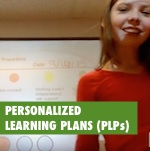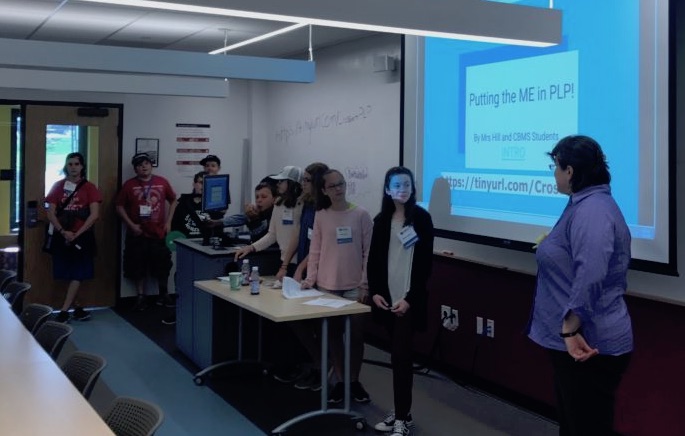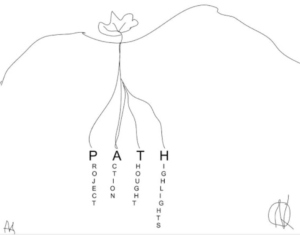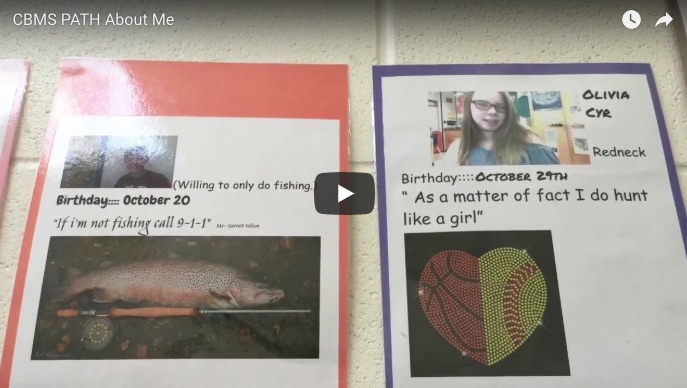One way to make sure PLPs are student-driven: hand them the keys
 At the end of last school year, the PLP Student Leadership Team at Crossett Brook Middle School presented to staff their recommendations for the future of PLPs at the school. And the staff unanimously supported all of the recommendations.
At the end of last school year, the PLP Student Leadership Team at Crossett Brook Middle School presented to staff their recommendations for the future of PLPs at the school. And the staff unanimously supported all of the recommendations.
But it’s one thing to come up with a bunch of great ideas. It’s another thing to make sure they happen. For this group of students, follow through was not a problem. They met during the summer to keep the momentum going, convened daily during the first few weeks of school, then rolled out the new PLP process to their peers.
From PLPs to student-driven P.A.T.H.s
Initial mediocrity motivated inquiry
When teachers launched PLPs during the 2015-16 school year, the intention was to increase student engagement and ownership. Similar to the PLP experience in many middle schools, the first try was more “meh” than marvelous.
The school hit pause on PLPs, pivoted, and launched a new experiment to revitalize student agency. Thus was born Brainado, Crossett Brook’s school-wide Genius Hour.
Meanwhile, a student leadership group was enlisted to help rethink PLPs. Their 15-month inquiry involved attending a PLP (re)Design day with students from other schools, meeting during an intervention block for several weeks to design “Dream PLPs,” participating in another PLP (re)Design day, facilitating a workshop at the Dynamic Landscapes conference, presenting recommendations to school staff, and planning during the summer.

As the school year started, when asked what was needed to roll out PLPs this year, the student group responded, “We got this. Oh, and let’s start with the name.”

New name for a new experience: Project. Action. Thought. Highlights.
The student leadership team noted early on that “PLP” had become a four-letter word to some students. They recommended rebranding via a new name.
Name suggestions were solicited and eventually voted upon. The winner was “P.A.T.H.,” which includes a loose acronym and presents so many cool logo opportunities!

Each student chooses their platform
Student leaders had also recommended that student should have the power to choose their platform. While PLPs had originally been created on (Classic) Google Sites using a template, each student’s P.A.T.H. would follow its own path. (Terrible, I know.)
For students who were less tech savvy, teachers requested a starting point (NOT a “template,” which had also become a four-letter word). So this “quick start P.A.T.H.” version using Google Slides as the platform was provided as one of the choices.
In the end, roughly one third of students used Google Slides, another third used Google Sites, and the last third were split between several platforms, including other website builders, Prezi, Blogger, and non-digital good old fashioned binders.
Student-led launch
Over the course of three 30 minute sessions, student leaders launched P.A.T.H. using a common slide deck that they had created together with the mentorship of Jen Hill, the librarian and student voice amplifier extraordinaire. Each homeroom had a pair of student leaders forging the path ahead. (Can’t help it.)
[huge_it_slider id=”17 “]
The introduction on day one framed P.A.T.H. as a tool to support personalized learning. Students traced the major components that each P.A.T.H. must contain, which included an About Me and portfolios for Student Led Conferences, as well as highlights of projects.
Student leaders explained that P.A.T.H. puts projects at the center. The goal setting, documentation of progress, and reflection on learning would all happen in relation to projects that students were already working on and that they were passionate about.
After this relatively brief introduction, student leaders provided tech support while their classmates explored platforms and began setting up their P.A.T.H.s.
It’s what’s inside that counts
By the third and final session of the launch, almost all students had their P.A.T.H. set up. Student leaders charged their peers with developing creative About Me sections that responded to a prompt:
- For grades 5-6: “What is important to know about me?”
- For grades 7-8: “What is important to know about me to help me learn?”
Teachers made sure to remind students of the various identity activities that they had engaged in during the first few weeks of school. Students were encouraged to draw on these and synthesize, extend them, or riff on them.
As a final positive spark, student leaders showed this video created by Jen Hill, who had been inspired by the work of students around the school.
Closing the loop
Students were asked to make their About Me pages fairly concise. This was meant to guard against students thoughtlessly plunking all of their identity work into their About Me. But it also reminded students of the audience.
During Student Led Conferences P.A.T.H. would serve as a presentation vehicle.
And as a tool for personalized learning, teachers would review students’ About Me sections.
Two staff meetings have been set aside for the purpose of providing time for teachers to review at least 10 P.A.T.H.s. each. During the first staff meeting, teachers will make notes about each of their students on a crib sheet. During the second staff meeting, teacher teams will analyze the crib sheet for patterns and themes. This will serve as the basis for thinking about how the information from students’ P.A.T.H.s can support personalized learning.
Will it work?
There are a lot of unanswered questions at this point.
Are students more engaged? Survey data suggests that students are more positive about P.A.T.H. than then were about PLPs. There are still a significant number of students who are skeptical about the process. Teachers are trying various strategies to build excitement and motivation. Plus the student leaders are available to help directly, which is a huge advantage.
Will P.A.T.H. improve personalized learning? It is probably too early to tell. In the past, though, the school had not set aside time to systematically review P.A.T.H.s. Closing the loop is a good starting point.
How will a project-based P.A.T.H. work out? We know that students at Crossett Brook are passionate about projects (for example, Renaissance Smartphones or building a go kart). Teachers are optimistic about the potential for that passion to translate into planning, documentation, and reflection on student P.A.T.H.s.
Ultimately we are seeing a grand experiment play out here. Surely it won’t be perfect, but we must remind ourselves that the proper comparison is to the original PLPs, which were largely perceived as teacher-directed.
Personally, I am optimistic about any innovation effort guided by student voice, especially when agency is a central goal. The mere fact that students are now leading the way makes this a promising path. (Sorry!)
How can students guide PLPs at your school?



This is fantastic. The work of all parties involved in you PLP/PATH redesign inspires us at FBS. Thank you all.
Very glad to help! We’d love to see what you and your students come up with!